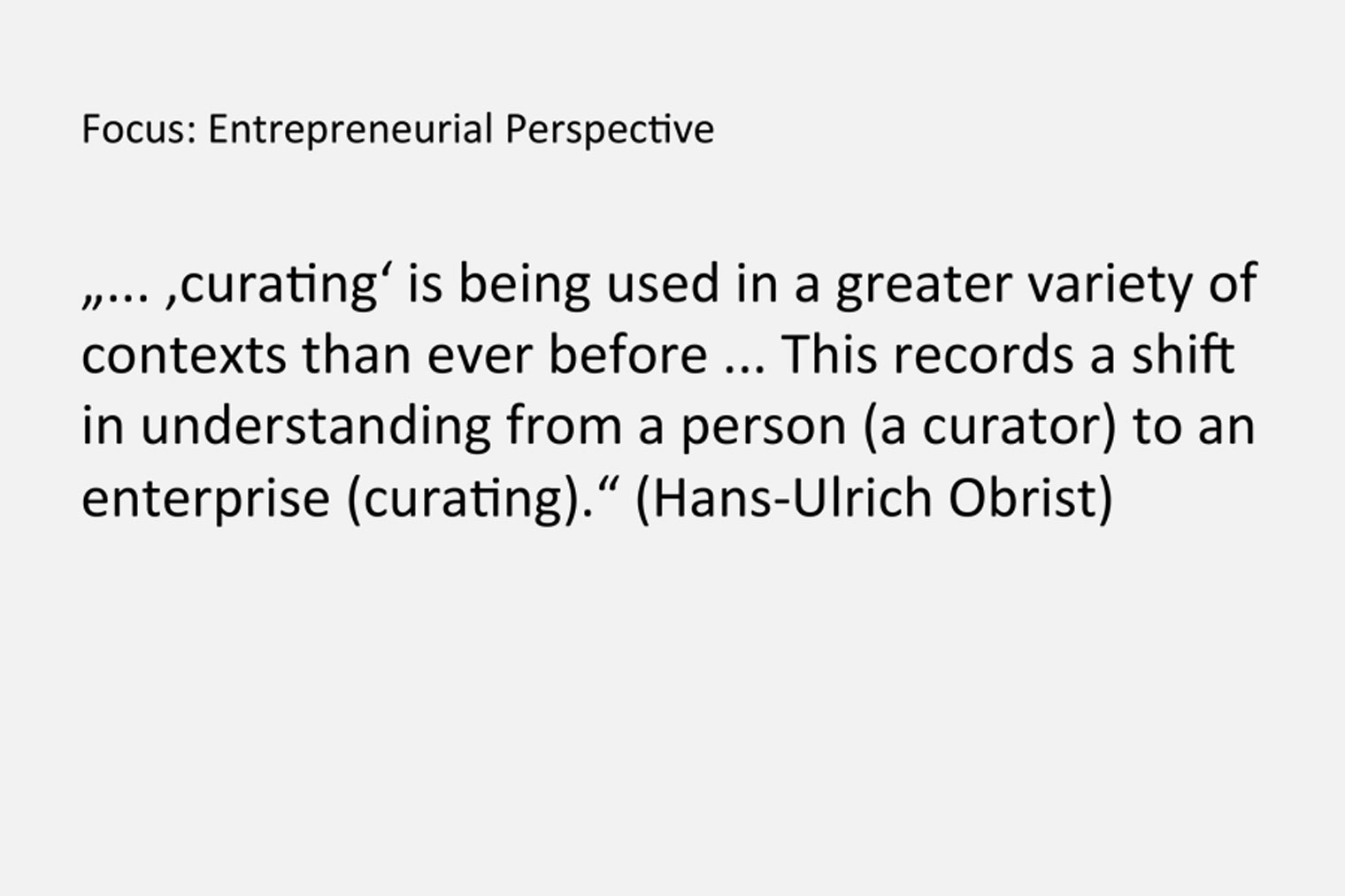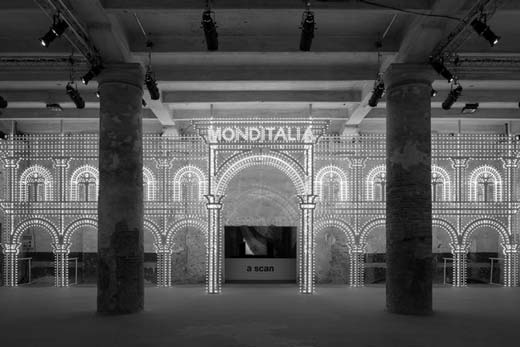Creativity Meets Organization
In order to enable creative processes, organizational contexts are essential. Simon Grand, assistant Professor for Strategic Management and Academic Director at St. Gallen University (CH), examines global creative systems from an entrepreneurial perspective.
A creative process is never just about the creative process itself. To even make creativity and creative processes possible, organizational contexts are essential. The one does not exist without the other, explained Simon Grand, assistant Professor for Strategic Management and Academic Director at St. Gallen University, and took a precise look on global creative systems from an entrepreneurial perspective.
Introducing an entrepreneurial perspective to our subject will help us to deal with the complexity in the art market. I will proceed in three steps: First, I would like to introduce shortly what I understand by an entrepreneurial perspective because we have a lot of big terms without really saying what we understand by them. Second, I suggest particular strategies and practices we can learn from entrepreneurial activities that might be important to deal with the complexity of global creative systems. And I actually see a certain parallel with the curatorial activity, which actually relates my presentation to the place where we are, which is I think a huge curatorial endeavour. Finally, a little outlook what I think would be a few implications of what I am trying to develop here.
Entrepreneurial perspective – no creativity without organizational context
So for me, first of all, an entrepreneurial perspective means that you don’t just look at global creative systems as they are from a distance trying to map or describe what they are. It’s a good discussion whether that’s actually possible to do or whether it’s more kind of a competition of different mappings. From an entrepreneurial perspective it’s more the question where are opportunities, developments, initiatives that might be generated within that broader context that brings us forward in one way or the other. Or to say differently: Entrepreneurial practices are about engaging forward, developing the global creative systems not as they are but as they could be. So what are the alternatives? And how do we create them, how do we bring them into being, how do we make novelty possible as an organized, a distributed phenomena?
Secondly, and here I quote Rei Kawakubo, the famous fashion designer behind “Comme des Garçons”. She made once this quote: „My work takes place where creating a company as a whole and creating clothes overlap. It cannot be one or the other.“ And this relates to something Gerd Folkers was also talking about. I think a creative process is not just about the creative process itself. But what are actually the organizational contexts we create to enable and make creativity and creative processes possible and Rei Kawakubo’s statement is actually connecting the two and saying there is not one without the other. So an entrepreneurial perspective means to think about creation and creating enabling condition for creation at the same time as an important activity.
And third, and now comes my curatorial kind of perspective into play. I think today we cannot talk about clearcut organizations any more. Probably its also difficult in the past but today what we observe is blurring boundaries. What is the organization and what are the interconnections, the interfaces, the connectivities actually among organizations, communities, actors that are important to make a creative process actually possible? Here I quote Hans-Ulrich Obrist:

Eight entrepreneurial strategies of dealing with the complexity of global creative systems
In the next few minutes I’d like to explain how – in my opinion – entrepreneurial strategies contribute to dealing with the complexity of a global creative system. At the same time I’d like to ask you if you think that this activity is also a curatorial activity and if there are any connections between the two.
Now each of these eight processes or practices I tried to describe are found in entrepreneurial practices in many different contexts. I propose to say that we can understand those eight practices also as curatorial practices and it would be interesting to explore some of that also in our discussion.
- First of all, given the complexity of global creative systems or global creative processes, I think there is no creative process without projecting. And by projecting I mean making a statement, a hypothesis, a proposition saying that would be something attractive interesting to do. Now the challenge is that this projection can always be wrong, it will be heavily criticized, it will be in competition with many other projections. So it is a very fragile thing actually to project something. That’s true in art practice, that’s true in a scientific practice but that’s also true when you found a company or when you do an exhibition like this. I also think there are some projections some pro-posals behind all that. Some hypothesis and propositions that are then tested and elaborated in such an environment.
- Given that, a second important element I think of entrepreneurial practices and strategies is not only to propose something but to materialize it. To make it tangible: as a prototype in business, as an experimental approach in a scientific community, as artwork in an artistic context. So it’s not just talking about those things but really materializing them, making them happen.
- And then there is a third fundamental element, which was implicitly present in all three or four presentations already this morning: judgement. To what extent is a proposition or a proposal or an initiative attractive, new, potentially successful, relevant, important, of quality and so on and so forth? Given the complexity we are talking about here, such judgements are not obvious. They are the result of complex processes themselves. So dealing with these judgements is a very important thing. There are some entrepreneurial and curatorial actors that actually focus their entire activities on being those jedges in these systems, providing ways of framing, interpreting and putting things together in one way or the other.
- A fourth important element is experimenting. So where do we try out new things before we actually understand them? What are the laboratories we work with? And as I understand for example the preparation of this Biennale is really the result of a long research and experimenting process, trying out the potential of multiple things of which we see some of the results now as the exhibition here. But without experimenting you don’t really grasp what normal ideas actually are and I assume today experimenting is a much more dispersed and heterogeneous thing than ever before.
- Fifth – and that’s now where Rei Kawakubo comes in again – it’s very important to think about organizing some of this experimenting. It’s not just trying out things but creating the environments, the context, the laboratories that allow us to ask interesting questions and develop interesting answers be it AMO, be it Harvard, be it Zurich University of the Arts or whatever else the places are to explore and to create those laboratories.
- The sixth important element I think is the resourcing of those processes. You need the financial resources, the skills, the knowledge, the experiences to actually build and bring new endeavours and new initiatives together. So we have to understand also the resourcing processes. How do they work? And some entrepreneurs but also some curators spend most of their time actually mobilizing the resources they need to make something happen.
- A seventh important element: You have to connect things you created with other things. Competing things, alternative things, critique and so on and so forth and I understand this process as a translation process. You constantly translate from one context to the other and try to reinterpret what you are doing and its relevance to many other contexts.
- The eighth element – which is really surprising when I talk to researchers in my research to entrepreneurs or also to artists and designers – is the enormous importance of context and particularly of history. So whatever we create in terms of novelty is embedded in what’s already here or what has been in the past. And an important process of actually generating the new is reinterpreting the past or rereading our own history as a resource to think about the future.
Three further important ideas: new routes, novelty and “what if?”
And now I come to a conclusion: What would be three important things we can pick up in our further discussion? How can we elaborate them based on what I tried to develop here?
First of all, again Hans-Ulrich Obrist: “[…] the task of curating is to make junctions, to allow different elements to touch … a form of map-making that opens new routes.“ What I find particularly interesting here is the way he uses the concept of maps. Namely not just as something representing the world as it is, but the way we describe the world already is a performative thing. We create the world through our description of the world because we reframe it, we give it a particular interpretation and by that, we open up what he describes as new routes.
Secondly, a quote by a researcher studying the development of science talking about what we need in our experimental systems. Settings, where we can explore novelty in a structured, equipped way. And he describes what a good experimental system is by saying: „Experimental systems are arranged in a way that they can give unknown answers to questions, which the experimenter cannot clearly formulate. They are ‚machines to manufacture the future‘.“ So that might be a second interesting thing to explore: how do we create such laboratories or experimental systems?
And the third one is now, what type of questions do we actually ask in such a context? And here a designer from California makes a very interesting suggestion in saying, if the impossible drives the possible, a designer – and I think also an entrepreneur and a curator – should ask the following question: „What if?“ What if something would be different than it is and what can we actually do in order to make that happen? Thank you for your attention.
